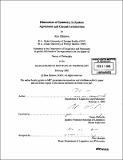Dimensions of symmetry in syntax : agreement and clausal architecture
Author(s)
Hiraiwa, Ken, 1974-
DownloadFull printable version (19.39Mb)
Other Contributors
Massachusetts Institute of Technology. Dept. of Linguistics and Philosophy.
Advisor
Noam Chomsky.
Terms of use
Metadata
Show full item recordAbstract
(cont.) are, then, determined at phase levels by late insertion of categorial features. One crucial aspect of the proposed theory of structural symmetry involves interweaving effects, which emerge as categorial determination of different sizes and types. The present thesis discusses three such cases: Nominative-Genitive Conversion, Head-Internal Relative Clauses, and Predicate Cleft Constructions. It is further argued that Agreement Symmetry and Structural Symmetry interact with the Case theory and bring far-reaching implications for aspects of syntactic phenomena. This thesis is a theoretical investigation of various dimensions of symmetry exhibited in human language. I discuss two kinds of symmetry: AGREEMENT SYMMETRY and STRUCTURAL SYMMETRY. Building on these types of symmetry, the chapters develop and articulate theoretical explanations for a variety of phenomena within the framework of the Minimalist Program and provide empirical verification backed up by a cross-linguistic study. AGREEMENT SYMMETRY manifests itself under Case and agreement phenomena in natural languages. In the literature, there have been various theoretical proposals to capture the mechanism of Case and agreement (e.g. Government, Spec-Head Agreement, Feature Checking etc.). I argue for a theory of Multiple Agree as a feature valuation theory. Under Multiple Agree, a probe P Agrees with all matching goals simultaneously. Given that valuation is in essence bi-directional, Multiple Agree reveals two natural probe-goal relations: Mirrorsymmetry and Centrosymmetry. Further, I also propose that a syntactic derivation allows Derivational Simultaneity and that syntactic operations apply simultaneously at a probe level. I call this the Probe Theory of Parallel Derivation (PTPD). It is demonstrated that Multiple Agree and the PTPD explain intricate agreement patterns in Icelandic and other languages. STRUCTURAL SYMMETRY is exhibited in geometric parallelism between clauses and nouns. Building on observations of CP/DP parallelism sporadically made in the literature, I argue that their symmetric properties are subsumed under the Supercategorial Theory of the CP/DP Symmetry. The supercategorial theory views "clausal" and "nominal" structures as arising from a category-neutral supercategorial structure. The categorial differences
Description
Thesis (Ph. D.)--Massachusetts Institute of Technology, Dept. of Linguistics and Philosophy, 2005. Includes bibliographical references (p. 347-373).
Date issued
2005Department
Massachusetts Institute of Technology. Department of Linguistics and PhilosophyPublisher
Massachusetts Institute of Technology
Keywords
Linguistics and Philosophy.